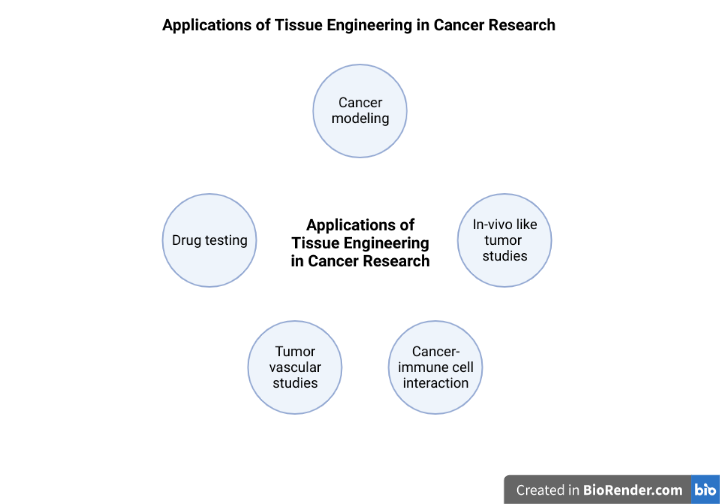
Role of tissue engineering in cancer research
Tissue engineering plays a significant role in cancer research by providing models to better understand cancer biology, develop new therapeutic strategies, and test potential treatments.
Some key aspects that tissue engineering contributes to cancer research are:
Cancer modeling
Tissue engineering allows scientists to create 3D tumor models, often referred to as “tumor organoids” or “tumoroids.” Tumor organoids can mimic the architecture, heterogeneity and serve as powerful tools for studying cancer progression, tumor growth, invasion, and metastasis.
Drug testing and personalized medicine
Researchers can test different anticancer drugs on patient-derived tumor organoids to predict individual patient responses to specific treatments. This has the potential to improve treatment efficacy and reduce the risk of adverse effects by tailoring therapies to each patient’s unique tumor characteristics.
Tumor angiogenesis and vascularization studies
Tissue engineering techniques are employed to study tumor angiogenesis, the process by which tumors create new blood vessels to supply nutrients and oxygen.
Investigating cancer-immune cell interactions
Tissue-engineered models can be used to investigate the interactions between cancer cells and immune cells within the tumor microenvironment which is essential for developing immunotherapies and understanding mechanisms of immune evasion employed by cancer cells. In vivo-like tumor microenvironment Tissue engineering allows researchers to recreate the complexity of the tumor microenvironment in vitro, which includes factors such as hypoxia, acidity, and mechanical forces. This enables a more comprehensive study of cancer biology and helps identify potential targets for novel therapies.
References
1. Han F, Wang J, Ding L, Hu Y, Li W, Yuan Z, Guo Q, Zhu C, Yu L, Wang H, Zhao Z, Jia L, Li J, Yu Y, Zhang W, Chu G, Chen S, Li B. Tissue Engineering and Regenerative Medicine: Achievements, Future, and Sustainability in Asia. Front Bioeng Biotechnol. 2020 Mar 24;8:83. doi: 10.3389/fbioe.2020.00083. PMID: 32266221; PMCID: PMC7105900.
2. Eldeeb AE, Salah S, Elkasabgy NA. Biomaterials for Tissue Engineering Applications and Current Updates in the Field: A Comprehensive Review. AAPS PharmSciTech. 2022 Sep 26;23(7):267. doi: 10.1208/s12249-022-02419-1. PMID: 36163568; PMCID: PMC9512992.
3. Olson JL, Atala A, Yoo JJ. Tissue engineering: current strategies and future directions. Chonnam Med J. 2011 Apr;47(1):1-13. doi: 10.4068/cmj.2011.47.1.1. Epub 2011 Apr 26. PMID: 22111050; PMCID: PMC3214857.



